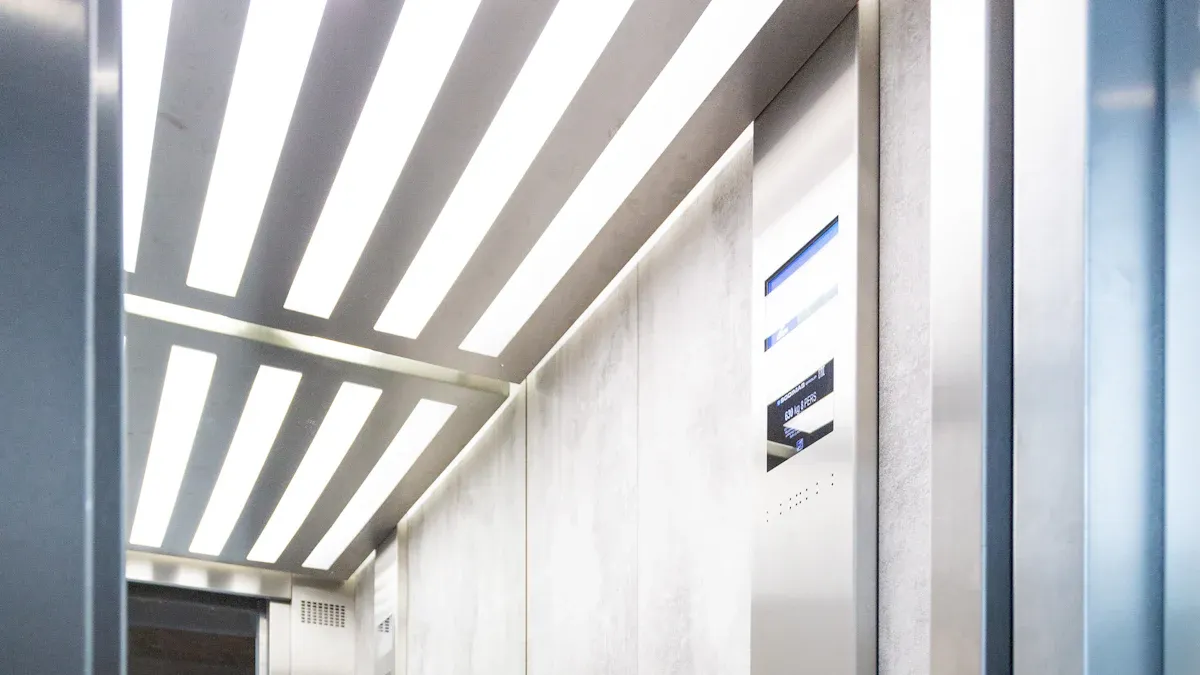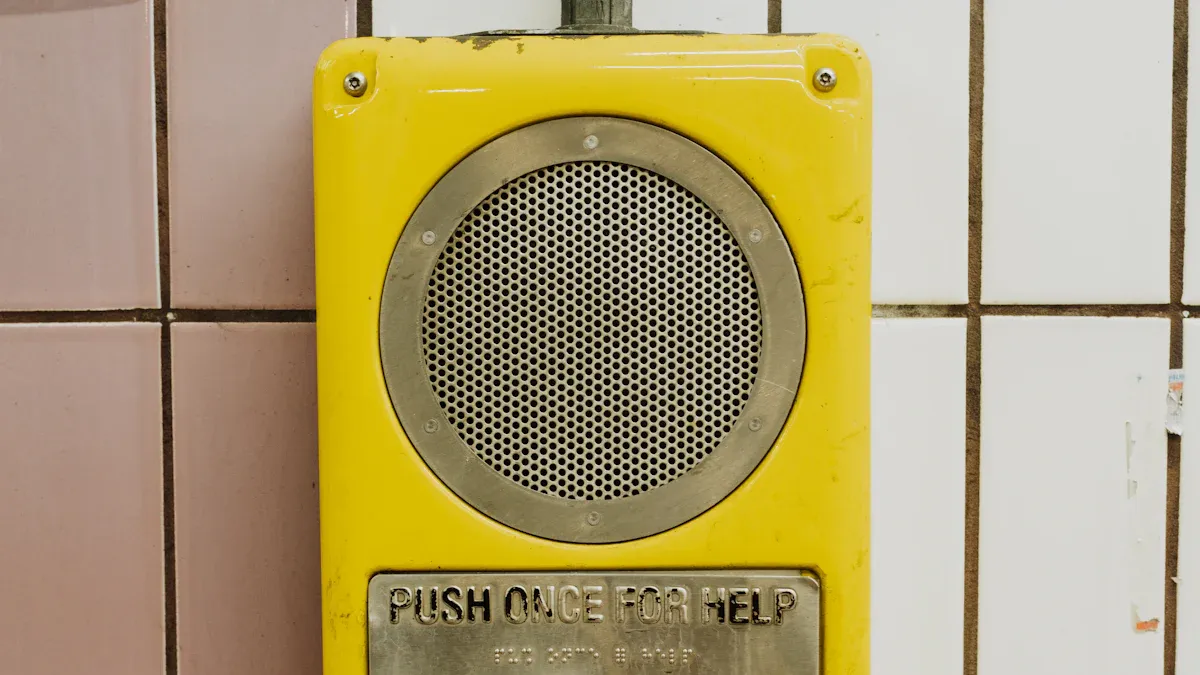
Elevator emergencies feel less frightening now. Handsfree elevator telephone systems speed up rescue by letting passengers speak without touching anything. Many buildings see a 30% drop in response times. People using an apartment elevator telephone 또는 심지어 handsfree Public Telephone at a station public telephone get help faster and feel safer.
The Evolution of Elevator Emergency Communication

Limitations of Traditional Elevator Phones
Traditional elevator phones once seemed like a big step forward, but they now show many weaknesses. These phones often use old copper lines, which telecom companies no longer support. When a building upgrades its phone system, elevator phones sometimes get disconnected by mistake, leaving passengers without a way to call for help. VoIP systems, which use the internet, can also cause problems. If the power goes out, the router stops working, and the elevator phone cannot make calls. Call quality may drop, and emergency responders may not know exactly where the call comes from.
- Analog phones are becoming outdated and hard to repair.
- VoIP phones need special setup to work well and can fail during power outages.
- Location tracking is unreliable, making it harder for help to arrive quickly.
- Sometimes, phone upgrades leave elevators with no emergency phone at all.
These issues show why many buildings look for better solutions.
Rise of the Handsfree Elevator Telephone
The handfree 엘리베이터 전화 changes how people get help in emergencies. This system lets passengers talk to rescue teams without picking up a handset. Modern handsfree elevator telephones use cellular networks or Power over Ethernet (PoE) to stay connected, even during power failures. Some models offer battery backups that last twice as long as old systems. They also support video calls and text messaging, which help people with hearing or speech problems.
Modern handsfree elevator telephones meet strict safety codes and work with many types of elevators. They use smart technology to monitor systems in real time and send alerts if something goes wrong. Installers can set them up quickly, often using the building’s existing wiring. These systems save money, reduce downtime, and make elevators safer for everyone.
Today, the handsfree elevator telephone stands out as a smart, reliable, and future-ready choice for emergency communication.
Technology Trends Shaping Handsfree Elevator Telephone Systems
AI-Powered Language Translation and Voice Recognition
Artificial intelligence (AI) is transforming how handsfree elevator telephone systems communicate. These systems now use AI-powered voice recognition to understand and respond to passengers more effectively. For instance, they can identify different languages and provide real-time translations, ensuring that non-native speakers can communicate during emergencies. This feature is especially useful in urban areas with diverse populations.
AI-driven voice recognition also improves accessibility. It allows passengers with speech impairments to use alternative communication methods, such as text-to-speech or pre-recorded messages.
Additionally, AI enhances emergency response by filtering background noise and focusing on the caller’s voice. This ensures that rescue teams receive clear and accurate information, even in noisy environments. By integrating these advanced features, handsfree elevator telephones are becoming smarter and more inclusive.
IoT Integration and Smart Monitoring
The Internet of Things (IoT) is revolutionizing elevator communication systems by enabling real-time monitoring and smart diagnostics. IoT sensors continuously collect data on elevator performance, such as speed, door operation, and power usage. This data helps detect potential issues before they become major problems.
- Predictive maintenance is one of the biggest benefits of IoT integration. By analyzing performance data, IoT systems can predict when components are likely to fail, reducing downtime and repair costs.
- Real-time monitoring provides live updates on elevator status, allowing technicians to address issues remotely. This minimizes the need for on-site visits and speeds up emergency responses.
- IoT also supports energy efficiency. By optimizing power consumption and scheduling maintenance during off-peak hours, these systems contribute to sustainability efforts.
Smart monitoring doesn’t just improve reliability; it also enhances passenger safety. For example, IoT-enabled systems can send alerts during power failures, ensuring backup systems activate immediately. This level of connectivity makes handsfree elevator telephones more dependable than ever.
Remote Diagnostics and Predictive Maintenance
Remote diagnostics and predictive maintenance are game-changers for elevator systems. These technologies allow technicians to monitor and troubleshoot issues without being physically present. For example, IoT-enabled systems can detect signs of wear and tear, such as unusual vibrations or temperature changes, and alert maintenance teams before a breakdown occurs.
A case study on IoT-based maintenance found that predictive models achieved up to 96% accuracy in identifying potential failures. This level of precision reduces unexpected downtime and extends the lifespan of elevator components.
Remote diagnostics also save costs by reducing the frequency of manual inspections. In Singapore, elevators with remote monitoring systems have transitioned from monthly to quarterly inspections, thanks to their reliability.
By adopting these technologies, building managers can ensure that handsfree elevator telephones remain operational during emergencies, providing a safer experience for passengers.
5G Connectivity and Power over Ethernet Solutions
The introduction of 5G connectivity is taking elevator communication to the next level. With faster data speeds and lower latency, 5G networks enable seamless communication between handsfree elevator telephones and emergency responders. This ensures that calls are clear and uninterrupted, even during high-traffic periods.
Power over Ethernet (PoE) is another innovation enhancing these systems. PoE allows both power and data to be transmitted through a single cable, simplifying installation and reducing costs. This technology is particularly useful for retrofitting older buildings with modern communication systems.
| Feature | Benefit |
|---|---|
| 5G Connectivity | Faster, more reliable communication during emergencies. |
| Power over Ethernet | Simplified installation and reduced infrastructure costs. |
| Battery Backup Systems | Extended operation during power outages, ensuring continuous safety. |
These advancements make handsfree elevator telephones more efficient and future-ready, meeting the demands of modern urban environments.
Regulatory Compliance and Industry Standards for Handsfree Elevator Telephone
ADA Accessibility and Inclusivity Requirements
Regulations now make elevators safer and more accessible for everyone. The Americans with Disabilities Act (ADA) sets clear rules for elevator emergency phones. These rules require hands-free operation so people with disabilities can use the phone without lifting a handset. Installers must place the phone no higher than 48 inches from the floor, making it easy to reach from a wheelchair.
Modern systems must provide two-way voice communication and automatic location identification. This means emergency responders know exactly where help is needed, even if the caller cannot speak.
Elevator phones must also include both audible and visual signals. These features help people with hearing or vision impairments. Regular testing and maintenance keep the system reliable. Some cities require scheduled tests to make sure everything works when needed. Freight and service elevators that serve as accessible routes must follow the same rules as passenger elevators.
Updated Codes and Safety Mandates
Industry standards keep evolving to improve safety. The ASME A17.1 and CSA B44 codes now require two-way messaging and video monitoring in elevator cabs. These updates help emergency personnel see and communicate with passengers during a crisis. Display screens can show messages from responders, letting riders know that help is on the way.
- New codes demand handsfree elevator telephone systems to work for at least four hours during power outages.
- Redundant connections, like cellular or VoIP, ensure the phone stays online even if one network fails.
- Specialized monitoring solutions provide 24/7 emergency response and lifetime maintenance.
A table of key safety features:
| Feature | Benefit |
|---|---|
| Two-way messaging | Assists hearing/speech-impaired users |
| Video monitoring | Allows visual assessment in emergencies |
| Display screens | Reassures passengers with real-time info |
These changes make elevators safer and more inclusive for everyone.
Addressing Challenges in Modernizing Elevator Emergency Communication
Integration with Existing Elevator Infrastructure
Modernizing elevator communication systems brings real challenges, especially in older buildings. Many property owners face high upfront costs when they try to upgrade. Sometimes, they need to reconfigure elevator shafts or even move machine rooms. This work can cause long periods when elevators are out of service, which frustrates tenants and visitors.
Other common hurdles include:
- Complex installations that require skilled technicians, who are sometimes hard to find.
- Regulatory rules that differ from city to city, making compliance tricky.
- Security concerns about new, connected systems.
To tackle these issues, building managers often plan projects carefully to reduce downtime. They choose smart technologies, like IoT sensors, for real-time monitoring and predictive maintenance. Upgrading to energy-efficient and safety-compliant parts also helps meet regulations and improve performance.
Ensuring System Reliability and Redundancy
Reliability matters most during emergencies. New systems use VoIP technology, which sends digital signals over the internet. If one internet path fails, the call can switch to another, so help is always just a button away. Some solutions, like AirDial, use both wired and wireless connections. If one network goes down, the other takes over. These systems also include battery backups that last more than eight hours. Real-time alerts let technicians know if something needs attention, keeping the handsfree elevator telephone ready for any emergency.
Managing Costs and Demonstrating ROI
Upgrading elevator phones can seem expensive at first. Owners worry about the cost of new equipment and installation, especially in older buildings. However, energy-efficient technologies, like regenerative drives, lower long-term costs. Careful planning and expert help can reduce downtime, which keeps tenants happy and avoids lost revenue. Many buildings see a return on investment through fewer repairs, better safety, and improved tenant satisfaction.
Real-World Applications of Handsfree Elevator Telephone Technology

High-Rise Residential Building Implementation
Many high-rise residential buildings now use handsfree elevator telephone systems to improve safety and communication. Residents feel more secure knowing they can reach help quickly, even if they cannot use their hands. Building managers report several benefits:
- Strong radio signal coverage on every floor, so there are no dead zones.
- Reliable two-way communication between residents and emergency responders.
- Real-time monitoring that keeps the system ready at all times.
- Easy integration with existing building communication networks.
Property teams also focus on training residents and staff. They run regular emergency drills and teach everyone how to use the system. These steps help build trust and make sure everyone knows what to do in an emergency. Many buildings now include detailed emergency action plans and clear communication protocols. This approach keeps tenants informed and prepared.
Market trends show that residential complexes want customized safety solutions. They look for energy-efficient devices and systems that meet strict building codes. Companies now design handsfree elevator telephone systems to fit these needs, making them a smart choice for modern living spaces.
Commercial Office Tower Success Story
Commercial office towers face unique challenges. They need to protect hundreds or even thousands of people every day. One downtown office tower upgraded its elevators with handsfree elevator telephone technology. The results impressed both tenants and building managers:
- The system met new safety regulations and passed all security audits.
- AI features allowed for faster, smarter emergency responses.
- The building reduced downtime and maintenance costs with real-time monitoring.
Sustainability also played a role. The tower chose energy-efficient devices to support green building goals. Despite the initial investment, the upgrade paid off by improving safety, meeting regulations, and boosting tenant confidence.
The handsfree elevator telephone keeps evolving as new technology and safety codes shape the future. Market forecasts show steady growth as cities modernize. Real-time monitoring, smart sensors, and strict compliance help create safer, more inclusive elevator rides. Building managers who stay proactive with upgrades protect everyone.
- Continuous innovation drives safer, smarter elevators.
- Compliance ensures every ride meets today’s standards.
제품 정보
How does a handsfree elevator phone work during a power outage?
Most handsfree elevator phones use battery backups. These batteries keep the phone working, so passengers can call for help even if the power goes out.
Can handsfree elevator phones help people who do not speak English?
Yes! Many systems use AI to translate languages in real time. This feature helps everyone communicate with emergency responders, no matter what language they speak.
Are handsfree elevator phones hard to install in older buildings?
Not really. Many models use existing wiring or wireless connections. Installers can often set them up quickly without major changes to the building.


